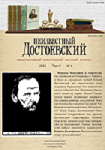Достоевский и исихазм: «Преступление и наказание»
Dostoevsky and Hesychasm: “Crime and Punishment”
Author(s): Tatiana A. KasatkinaSubject(s): Christian Theology and Religion, Russian Literature, Sociology of Religion, Sociology of Literature
Published by: Петрозаводский государственный университет
Keywords: Dostoevsky; hesychasm; The Philokalia; Crime and Punishment; The Drunken; biblical quotes; author’s theory of art;
Summary/Abstract: Not much has been said about Dostoevsky and hesychasm, and mainly with the greatest evidence and persuasiveness in the case when direct references to the figures of hesychasm appeared directly in the text of Dostoevsky’s novel (“The Brothers Karamazov”). However, hesychasm can be considered as an optimal explanatory structure already for the novel “Crime and Punishment.” In this novel hesychasm is most obviously present, not from the point of view of superficial references or an external plot developing in the “apparent flow of life” (as Dostoevsky designated what happens on the surface of being), but from the point of view of the deepest plot, in which what happens in the novel is connected with “ends and beginnings” (so Dostoevsky called the origins and the results of events that are beyond the obvious, beyond time). The original title of the novel, “The Drunkards,” which later became “Crime and Punishment,” as well as the characteristics of the characters found in “Crime and Punishment” (to be “drunk without wine,” to be mistaken for a drunk in a sober state, to hide behind the illusion of intoxication their preand post-criminal state), strictly associate drunkenness with sin and a crime. The direct opposition to this state is sobriety, which the participants of the Hesychast tradition strive to achieve, and the collection of texts of this tradition, “Philokalia,” is called in the translation by Paisii Velichkovsky: “Words and Beginnings of Sacred Sobriety.” The separation of heart and mind, which characterizes the two main criminal characters of the novel, is the main characteristic of the pre-natural state of a person according to hesychasm. Hesychasm also makes it possible to explain why the heroine, who occupies the highest position in the spiritual structure of the novel, is characterized by the words “She will see God.
Journal: Неизвестный Достоевский
- Issue Year: 9/2022
- Issue No: 4
- Page Range: 171-185
- Page Count: 15
- Language: Russian

